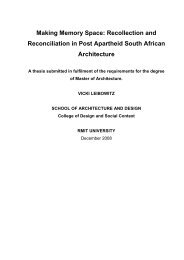Objects in Flux - RMIT Research Repository - RMIT University
Objects in Flux - RMIT Research Repository - RMIT University
Objects in Flux - RMIT Research Repository - RMIT University
Create successful ePaper yourself
Turn your PDF publications into a flip-book with our unique Google optimized e-Paper software.
[Figure 5-28]<br />
L<strong>in</strong>ear encoder, 2006.<br />
It’s a l<strong>in</strong>ear encoder, just like the mouse’s encoder wheel<br />
except straight. I presume it was used by the pr<strong>in</strong>ter to check<br />
pr<strong>in</strong>t head movement.<br />
[Figure 5-29]<br />
L<strong>in</strong>ear encoder – detail, 2006.<br />
Here’s a close-up. The perforated strip alternately blocks or<br />
allows light to pass between an optical encoder’s send and<br />
receive modules.<br />
[Figure 5-30]<br />
Test<strong>in</strong>g the l<strong>in</strong>ear encoder, 2006.<br />
Here you can see the mouse’s circuit board liberated from<br />
its enclosure and positioned on the strip so that left and right<br />
Tell<strong>in</strong>g Stories<br />
sumption and my general belief structures.<br />
Through this journey I have developed a deep<br />
familiarity with specific objects and processes.<br />
This experience is, however, different from be-<br />
<strong>in</strong>g an expert <strong>in</strong> a particular field; my knowl-<br />
edge is materially and contextually sited with<strong>in</strong><br />
my own life. Practices of object modification en-<br />
gage the world <strong>in</strong> a very immediate and physi-<br />
cal way. There is someth<strong>in</strong>g primitive about<br />
this form of engagement <strong>in</strong> that it describes an<br />
<strong>in</strong>timate and responsive relationship between<br />
the <strong>in</strong>dividual and their surround<strong>in</strong>gs. xxvi Rather<br />
than be<strong>in</strong>g the antithesis of consumer practices<br />
this relationship runs through acts of consump-<br />
tion, resid<strong>in</strong>g at the localized po<strong>in</strong>t <strong>in</strong> time and<br />
space where <strong>in</strong>dividuals negotiate themselves<br />
<strong>in</strong>to the world. Our ability to speak of this<br />
relationship as ‘primitive’ highlights the extent<br />
to which commercial entities have structured<br />
and obscured the <strong>in</strong>dividual’s relationship to the<br />
material environment.<br />
While my engagement with hack<strong>in</strong>g and mod-<br />
d<strong>in</strong>g practices produced an <strong>in</strong>creased sense of<br />
personal agency, it also brought a degree of<br />
tension. As I hacked or modified an object I<br />
xxvi. I use the term ‘primitive’ here <strong>in</strong> a similar<br />
sense to Col<strong>in</strong> St. John Wilson’s description of<br />
architect Eileen Gray <strong>in</strong> The Other Tradition<br />
of Modern Architecture. Here Wilson claims<br />
Gray’s practice has an ‘<strong>in</strong>timacy, responsiveness<br />
and authenticity that we normally consider<br />
to be unique to those structures that we call<br />
‘primitive’, that is to say, carried out by the<br />
<strong>in</strong>habitants themselves, us<strong>in</strong>g only their own<br />
hands and the materials locally to hand, cop<strong>in</strong>g<br />
with the prevail<strong>in</strong>g environment, develop<strong>in</strong>g any<br />
and every advantage from local topography, and<br />
erect<strong>in</strong>g means of defence aga<strong>in</strong>st any adverse<br />
conditions’ (1995, p. 170).<br />
101
















